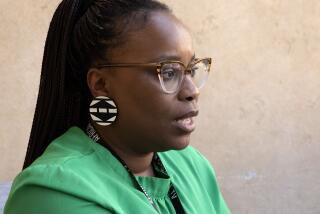Tour de Film : It’s a Free, No-Nonsense Amble Through the State-of-the-Art Cinema-Television Center, a Cluster of Five Buildings at USC
- Share via
If you’re looking for an unedited and uncensored look at Hollywood movie-making, where a quiet kid from Indiana may be a 16-millimeter film away from becoming the next Steven Spielberg, drop by USC’s School of Cinema-Television for a one-hour tour any Friday afternoon.
There are no tickets to buy, lines to wait in or trams to whisk you past shaking buildings, towering infernos and parting Red Seas. What you get is no-nonsense talk on the state of the art and the state of the filmmaker’s mind.
“Film school pretty much eats your life,” says Cricket Peters, a graduate film student and film-school tour guide.
“She’s right,” echoed Jeff Fine, a graduate student who is adding sound and special effects to his film, “Sandman,” a ‘60s beach thriller. “We basically save rent by sleeping here.”
Visitors can judge for themselves whether film students are a little crazy or just zealously committed to their craft.
Most of the action occurs inside the Cinema-Television Center, a cluster of five specialized buildings--with names familiar to Hollywood followers--that function as a combined educational center and motion picture and television studio.
The center also contains the USC Cinema Special Collections Library. There, you’ll discover that the roots of the film school go back to 1929, when the first course in film, “Introduction to Photoplay,” was offered. Likewise, you’ll learn that USC established the Department of Cinematography in 1932 and offered the country’s first bachelor of arts degree in film.
Tours begin at 2:30 p.m., starting from the loading dock in front of the spacious center. There, screenwriters, producers, directors, animators and a complete cast of filmmakers chat with other students about the various phases of their productions.
At the one public phone next to the loading dock, students wait impatiently in line to clinch their version of the big Hollywood deal. Students call up friends and call in favors to serve as dolly grips, prop masters and production designers in exchange for all the food they can eat. Of course, they fail to mention that the film school commissary consists of two vending machines--one for candy and the other for soft drinks.
“While it’s not the Polo Lounge, we can pretend,” says Peters, referring to the mega-movie deals made at the Beverly Hills Hotel.
As at any major commercial studio, you may see a little or a lot, depending on filming schedules.
“If you don’t see everything the first time, come back as many times as you like,” says Peters.
On the tour--started in response to people wondering what was going on inside these big-name buildings--sightseers will see:
* George Lucas Instructional Building--The largest building in the complex, it houses faculty, administrative and program offices, three theaters, four screening rooms, conference rooms and the Ann and Jack Warner Hall of Cinema. The receptionist sits at Jack Warner’s original desk. But perhaps the most fascinating and mind-altering part of the tour is the Computer Animation Room, which displays combined advances in computer science with cinema. You can slip on a data glove connected to a computer and play the piano without the actual piano. There is also a “virtual reality” demonstration used by animators, which features a blinking, breathing Max Headroom-type character that follows you around the room. Another demonstration on interactive television, yet to be released on the market, allows you to design your own tour of the Smithsonian Institution.
* Marcia Lucas Post-Production Building--To enter the facility, students cross a bridge, where etched in cement are the prophetic words, “Reality Ends Here.” At crunch time--whenever assignments are due--activity shifts to the “Bullpen,” where much of the general editing and negative-cutting occurs. Stressed-out students recently rewrote the theme to “Gilligan’s Island” based on their worst fear of being trapped in the Bullpen.
Students also use their imagination to create special-effect noises--from doors slamming to the whup whup whup of police helicopters--in the Foley Sound Room. According to Peters, all the animal sounds that you hear on “Wild Kingdom” and “National Geographic” specials are dubbed or looped after filming. “It’s kind of dangerous to make the sound guy go up next to the lion and record its roar,” she says.
* Steven Spielberg Music Scoring Stage--This is a 2,200 square-foot building, where live music from soloists to full orchestras is matched to videotape. USC’s Music Department even uses the facility’s microphones because of their superior sound quality.
* Carson Television Stage--The 50-by-70-foot video stage currently houses sections of the “Moonlighting” set along with a panoply of props and appliances for student productions. Students also edit “dailies,” the raw footage shot each day, from an on-line editing suite in the studio.
* Harold Lloyd Motion Picture Sound Stage--The 50-by-70-foot motion picture sound stage is made of pressboard so that students can nail their sets directly into the floor (“It beats lugging sandbags around,” Peters says). The building also contains several soft focus lights better known by the students as “Joan Collins” lights, which smooth out unsightly wrinkles “and make you look 15 again.”
Tours of USC’s Cinema-Television Center begin at 3450 Watt Way. From Vermont Avenue, go east on Jefferson Boulevard to McClintock. Turn right through Gate 5 for $5 parking. For more information, call (213) 740-2892.
More to Read
Only good movies
Get the Indie Focus newsletter, Mark Olsen's weekly guide to the world of cinema.
You may occasionally receive promotional content from the Los Angeles Times.










